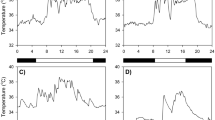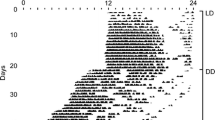Abstract
The effect of ambient temperature on the daily running activity of the red squirrel TAMIASCIURUS HUDSONICUS was investigated. Running-wheel activity (min/day) of live-trapped male and female animals was monitored for 7 days in the laboratory after 10–16 days adaptation at environmental temperatures of 10°, 20°, 30° and 35°C and the mean daily activity correlated with Ta. The data show that activity and environmental temperature are inversely related. It is believed that the level of spontaneous running-wheel activity at these temperatures is a function of the heat balance of the animal.
Zusammenfassung
Die Wirkung der Umgebungstemperatur auf die Laufaktivität des Rothörnches, TAMIASCIURUS HUDSONICUS wurde im Laboratorium untersucht. Die Laufaktivität (Min./Tag) von lebend gefangenen männlichen und weiblichen Tieren wurde in einer Temperaturkammer nach je 10–16 Tagen Anpassung nacheinander bei Umgebungstemperaturen von 10°, 20°, 30° und 35°C als Mittel aus 7 Tagen-Versuche berechnet und mit der Temperatur korreliert. Die Werte zeigen, dass die Umgebungstemperatur und spontane Laufaktivität negativ korreliert sind. Es wird die Auffassung vertreten, dass das Ausmass der Laufaktivität bei diesen Temperaturen eine Funktion des Wärmegleichgewichtes der Tiere ist.
Resume
On a observé en laboratoire les effets de la température ambiante sur les déplacements de l'écureuil roux (TAMIASCIURUS HUDSONICUS). Pour l'expérience, on a utilisé des animaux des deux sexes capturés vivants et placés successivement, après 10 à 16 jours d'adaptation, à des températures de 10°, 20°, 30° et 35°C. On a ensuite calculé la corrélation entre la moyenne journalière (en minutes/jour) de 7 jours d'exposition d'une part, la température d'autre part. Les résultats montrent que la température ambiante et l'activité déambulatoire spontanée de cette sorte d'écureuils sont en relation inverse. On pense que l'importance de cette activité est fonction, par ces températures, de l'équilibre thermique des animaux examinés.
Similar content being viewed by others
References
BAKER, R.H. (1944): An ecological study of tree squirrels in eastern Texas. J. Mammal., 25: 8–24.
BROBECK, J.R., WHEATLAND, M. and STROMINGER, J.L. (1947): Variations in regulation of energy exchange associated with estrous, diestrus, and pseudopregnancy in rats. Endocrinology, 40: 65–72.
BROWMAN, L.G. (1937): Light in its relation to activity and estrous rhythms in the albino rat. J. exp. Zool., 75: 375–388.
BROWMAN, L.G. (1942): The effect of bilateral optic enucleation on the voluntary muscular activity of the albino rat. J. exp. Zool., 91: 331–344.
BROWN, L.E. (1956): Field experiments on the activity of the small mammals, APODEMUS, CLETHRIONOMYS, and MICROTUS. Proc. Zool. Soc. (Lond.), 126: 549–564.
DICE, L.R. (1921): Notes of the mammals of interior Alaska. J. Mammal., 2: 20–28.
DUNCAN, D.B. (1955): Multiple range and multiple F tests. Biometrics, 11: 1–42.
FREGLEY, M.J. (1956): Relationship between ambient temperature and the spontaneous running activity of normal and hypertensive rats. Amer. J. Physiol., 187: 297–301.
FREGLEY, M.J., MARSHALL, N.B. and MAYER, J. (1957): Effects of changes in ambient temperature on spontaneous activity, food intake, and body weight of goldthioglucose-obese and nonobese mice. Amer. J. Physiol., 188: 435–438.
GOLLNICK, P.D. and IANUZZO, D.C. (1968): Colonic temperature response of rats during exercise. J. app. Physiol., 24: 747–750.
HALL, E.R. and KELSON, K.R. (1959): The Mammals of North America. Ronald Press Co., New York, Vol. 1, 546 pp.
HAMILTON, W.J. Jr. (1939): Observations of the life history of the red squirrel in New York. Amer. Midland Natur., 22: 732–745.
HARDY, J.D. (1949): Heat transfer. In: Physiology of Heat Regulation and the Science of Clothing. L.H. Newburgh (ed.), Hafner Publishing Co., New York, 78–108.
HART, J.S. (1961): Physiological effects of continued cold on animals and man. Brit. Med. Bull., 17: 19–24.
HART, J.S. and JANSKY, L. (1963): Thermogenesis due to exercise and cold in warm and cold-acclimated rats. Canad. J. Biochem., 41: 629–634.
HATT, R.T. (1929): The red squirrel: its life history and habits, with special reference to the Adirondacks of New York and the Harvard Forest. Roosevelt Wildlife Annals. Syracuse Univ. Vol. 2, 146 pp.
IRVING, L. (1964): Terrestrial animals in cold: birds and mammals. In: Adaptation to the Environment. Handbook of Physiology, Sec. 4. D.E. Dill, E.F. Aldolf and C.G. Wilber (ed.), Williams and Wilkins Comp., Baltimore, 361–377.
IRVING, L., KROGH, H. and MONSON, M. (1955): The metabolism of some Alaskan mammals in winter and summer. Physiol. Zool., 28: 173–185.
KAVENAU, J.L. (1969): Influences of light on activity of small mammals. Ecology, 50: 548–557.
KLEIBER, M. (1961): The Fire of Life. John Wiley and Sons, Inc., New York, 454 p.
KLUGH, A.B. (1927): Ecology of the red squirrel. J. Mammal., 8: 132.
LAYNE, J.N. (1954): The biology of the red squirrel, TAMIASCIURUS HUDSONICUS LOQUAX (Bangs), in central New York. Ecol. Mongr., 24: 227–267.
LORD, R.D. Jr. (1964): Seasonal changes in the activity of penned cottontail rabbits. Animal Behav., 12: 38–41.
McADAMS, W.H. (1954): Heat transmission. McGraw-Hill, New York, 532 p.
MILLAR, J.S. (1970): The breeding season and reproductive cycle of the western red squirrel. Canad. J. Zool., 48: 471–473.
MOUNT, L.E. and WILLMOTT, J.V. (1967): The relation between spontaneous activity, metabolic rate, and the 24-hour cycle in mice a different environmental temperatures. J. Physiol. (Lond.), 190: 371–380.
NELSON, B.A. (1945): The spring molt of the northern red squirrel in Minnesota. J. Mammal., 26: 397–400.
RHOADES, R.A., WRIGHT, R.A., HIATT, E.P. and WEISS, H.S. (1967): Metabolic and thermal response of the rat to a heliumoxygen environment. Amer. J. Physiol., 213: 1009–1014.
RICHTER, C.P. (1965): Biological clocks in medicine and psychiatry. Charles Thomas, Publisher, Springfield, 109 p.
RICHTER, C.P. and WANG, G.B. (1926): New apparatus for measuring the spontaneous mobility of animals. J. lab. clin. Med., 12: 289–292.
ROVETTO, M.J. (1957): Temperature adaptation in TAMIASCIURUS HUDSONICUS. M.S. Thesis, University of Idaho.
ROVETTO, M.J. and FERGUSON, J.H. (1971): Effects of acclimation temperature of brown adipose tissue in the red squirrel (TAMIASCIURUS HUDSONICUS). Comp. Biochem. Physiol., 39: 39–41.
SMITH, C.C. (1968): The adaptive nature of social organization in the genus of tree squirrels TAMIASCIURUS. Ecol. Monogr., 38: 31–63.
STEEL, G.D. and TORRIE, J.H. (1960): Principles and Procedures of Statistics. McGraw-Hill, New York, 481 pp.
Author information
Authors and Affiliations
Rights and permissions
About this article
Cite this article
Clarkson, D.P., Ferguson, J.H. Environmental temperature versus spontaneous running—wheel activity in the red squirrel, TAMIASCIURUS HUDSONICUS. Int J Biometeorol 16, 269–276 (1972). https://doi.org/10.1007/BF01553738
Received:
Issue Date:
DOI: https://doi.org/10.1007/BF01553738




